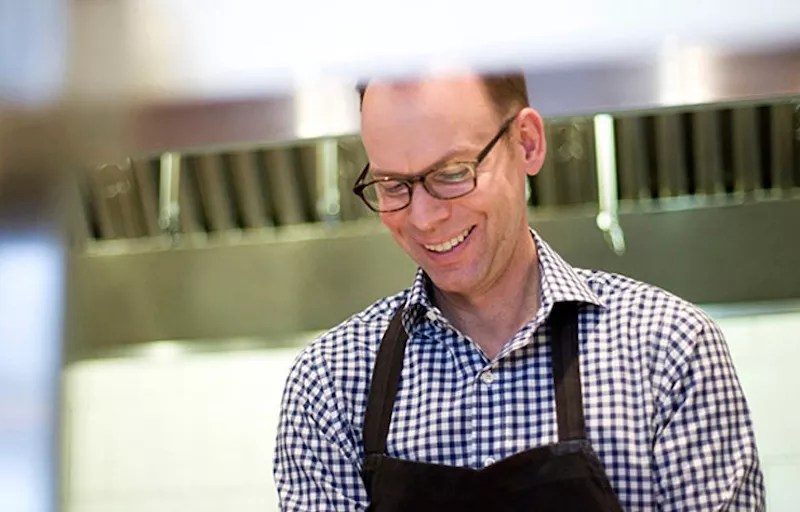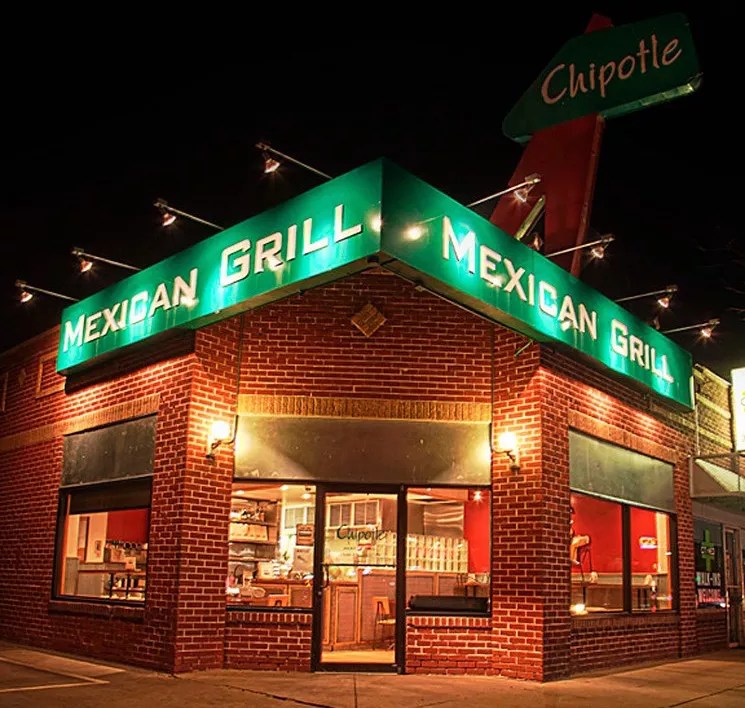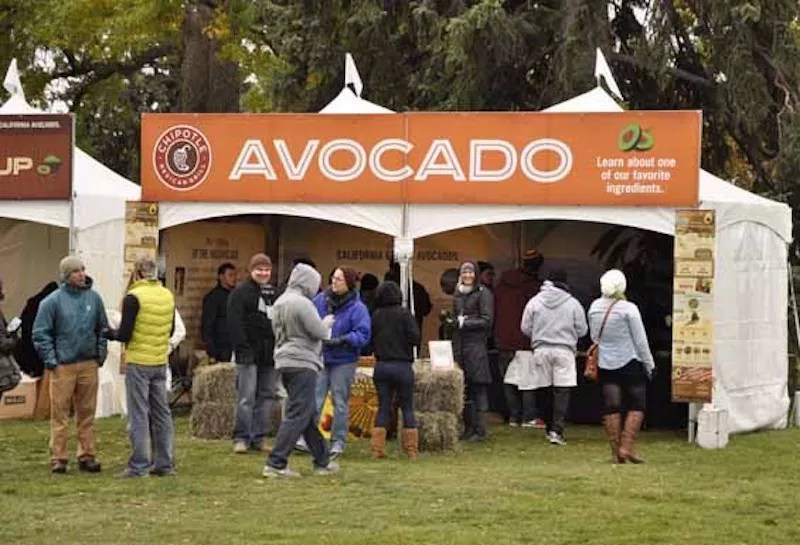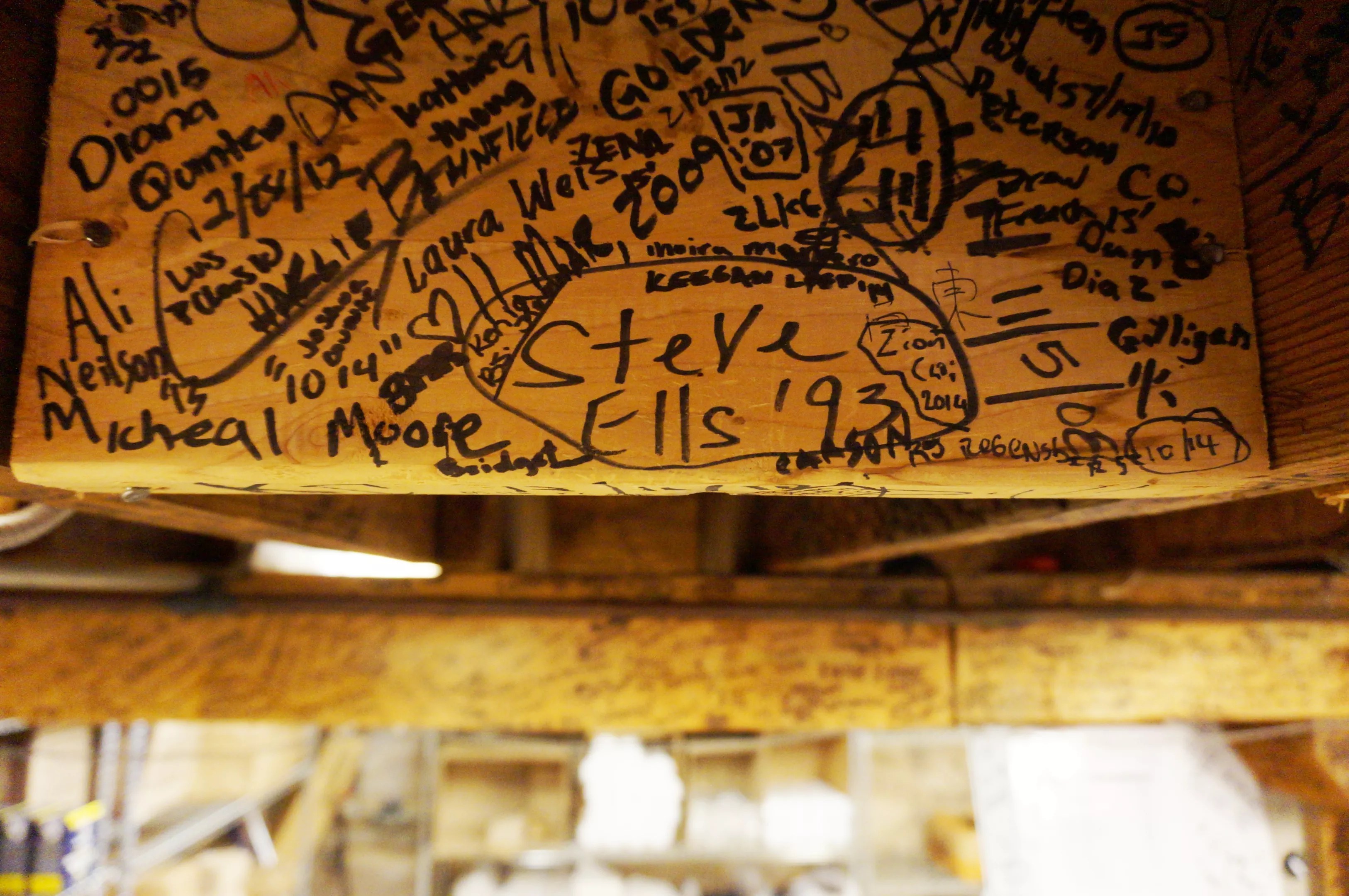
Anthony Camera

Audio By Carbonatix
News came down last week that Steve Ells is resigning from the CEO position at Chipotle, closing the door on a nearly 25-year chapter during which he grew the burrito company from a tiny shop on Evans Avenue – originally intended to be a cash cow for the fine-dining restaurant he was plotting – to more than 2,300 locations globally. Chipotle launched a restaurant revolution, creating a whole new industry segment by spawning fast-casual imitators and stoking a conversation about sustainable sourcing that spread to all corners of the restaurant world.
Here we look back at the ten most significant moments in Chipotle history, listed in chronological order. Note that we can’t wait until we can add an eleventh item to this list: the moment the world finally learns to pronounce “Chipotle.”

A photo of the original Chipotle hangs in all locations of the chain.
Anthony Camera
1993: The beginning
Chipotle has radically reshaped the restaurant industry, so much so that it’s hard to remember just how revolutionary it was. In 1993, though, quick-service restaurants were mainly fast-food joints – the notion of applying high-end cooking techniques to fast, casual service hadn’t yet proliferated. And then Ells, who’d trained under the legendary fine-dining chef Jeremiah Tower at San Francisco’s Stars, opened Chipotle on Evans, taking Mission-style burritos as inspiration and turning them into something completely new. Chipotle’s value proposition was its higher-end ingredients and classic cooking technique – and a transparent service model that allowed patrons to assemble customized meals on the fly. Denver responded enthusiastically, flooding the restaurant with business. Ells had originally intended to use that cash to build an upscale restaurant of his own. Instead, he infused it into new locations, which were just as busy as the first.
1998: McDonald’s becomes a major investor
By 1998, Chipotle had become a locally grown chain of sixteen restaurants. And then it got an infusion of cash from McDonald’s, which allowed it to build out a supply-chain infrastructure and move beyond Colorado’s border – first into Kansas City – even as Ells and his leadership team maintained control of the brand and operations. By the time McDonald’s divested eight years later, Chipotle was operating more than 500 restaurants.
1999: The start of Food With Integrity
Ells says his commitment to better sourcing started when he was looking for a better pork for his carnitas, the original iteration of which didn’t have enough flavor. He read about Niman Ranch, where Paul Willis raised his pigs on pastures or in deeply bedded pens, without growth hormones or antibiotics. The flavor of the pork spoke for itself to Ells, igniting an ongoing pursuit of better-quality ingredients. Company-wide greening spilled over into other realms of the business: several restaurants were constructed with an eye toward such markers as the U.S. Green Building Council standards of environmentally friendly building, including an Illinois restaurant partially powered by a wind turbine on its roof. Food With Integrity may be Chipotle’s greatest legacy: It’s reshaped how other quick-service restaurants think about sourcing, created a massive market for sustainably raised ingredients, and encouraged the entire industry to take a closer look at where food comes from.
January 2006: The IPO
On January 26, 2006, Chipotle made its initial public offering, with share price doubling as soon as the stock hit the market. Chipotle quickly became an investor darling, and the IPO marked the beginning of the end of McDonald’s involvement in the chain – the burger conglomerate sold off its stake in October of the same year.
2008: Going international
As Chipotle became a mainstay in every corner in the United States, it crossed international boundaries for the first time: Toronto got its first Chipotle in August 2008. Since then, the company has opened seventeen restaurants internationally – in Canada, the United Kingdom, France and Germany.

Chipotle’s Cultivate Festival brought food education and musical acts to one place.
Elyse Mitchell
2011: Chipotle Cultivate Foundation launches
Building on its commitment to sustainable sourcing, Chipotle launched a nonprofit organization called the Chipotle Cultivate Foundation, which supports and promotes good land stewardship, good animal-husbandry practices, food literacy and better nutrition. In 2011, the inaugural Cultivate festival was held in Chicago; the band Calexico headlined, and national and local celebrity chefs were there. Over the years, the Cultivate Foundation has made significant donations to organizations like Jamie Oliver’s Food Revolution, FarmAid and the Boulder-based Kitchen Community. The foundation has supported causes that range from agricultural rehabilitation among refugee communities to school gardens to land preservation and stewardship.
2011: Back to the Start
In conjunction with the launch of Cultivate, Chipotle released “Back to the Start,” an animated short set to a Willie Nelson cover of Coldplay’s “The Scientist.” The ad, which aired in theaters, was the pinnacle of, and a shift in, a long history of innovative advertising: In the beginning, Chipotle refused to run TV spots, focusing instead on cheeky and irreverent billboards and bus banners as well as burrito giveaways. After “Back to the Start,” which garnered millions of views and raised money for Cultivate via sales on iTunes, the company’s advertising continued to focus on promoting sustainable agriculture; Chipotle followed up a few years later with “The Scarecrow,” featuring a Fiona Apple cover of the song “Pure Imagination.”
September 2011: ShopHouse launches
Bent on proving that the Chipotle model of quick service and good sourcing could apply to cuisines beyond Mexican food, the company launched ShopHouse Southeast Asian Kitchen in Washington, D.C. The restaurant dealt in noodles, rice and, at the outset, banh mi sandwiches, built on flavors from Thailand, Vietnam and Malaysia, with meals assembled via the classic Chipotle-style line. In contrast to Chipotle, which has had more or less the same menu since 1993, ShopHouse was forever tweaking its list of offerings, including changing items based on availability of seasonal ingredients. While the concept eventually expanded to fifteen locations, Chipotle shuttered all of its ShopHouse restaurants in 2017. Its experiment with ShopHouse, however, also led to the launch of a burger concept called Tasty Made, the sole outlet of which continues to operate in Ohio, and investment in Pizzeria Locale, a Boulder-born Neapolitan-style pizzeria from Frasca owners Lachlan MacKinnon-Patterson and Bobby Stuckey.
2015: The food-safety scandals
Chipotle seemed untouchable until it was rocked by a series of 2015 food-safety scandals that sent its stock and business plummeting. A confluence of e. coli, salmonella and norovirus incidents led the restaurant to close all of its restaurants for one day in February of 2016 for an all-staff meeting on food safety. After a tough year of sales, Chipotle seemed on the road to recovery in 2017, until a July norovirus outbreak sent the stock falling again.

Chipotle founder Steve Ells signed his name on a basement beam in 1993, the year the company launched.
Mark Antonation
2017: Remodeling the original location
Every Chipotle features a photograph of the original Evans Avenue Chipotle, which for nearly 25 years functioned much the same way as it had when Ells first opened up shop. Unlike subsequent locations, it lacked the traditional line experience, its ingredients instead displayed on an L-shaped counter. In the low-ceilinged basement, Chipotle employees from across the decades signed the beams, taking their cue from Ells himself, who used a permanent marker to pen “Steve Ells ’93.” In 2017, though, the company remodeled the original restaurant – adding more space for employees with a larger kitchen and a completely overhauled basement. The service at the counter is still unique in the Chipotle empire, but thankfully, the newly dug-out basement still holds many of those signed beams, visible as employees descend the staircase that replaced the original trap oor and ladder.